Advancements in Battery Management Systems for Electric Vehicles: A MATLAB-Based Simulation of 4S3P Lithium-Ion Battery Packs
Abstract
1. Introduction
2. Literature Survey
2.1. Overview of Current BMS Technologies
2.2. Recent Advances in Computational Intelligence for BMS
Comparative Analysis
2.3. Gap Analysis
2.4. Main Contributions
3. Methodology
3.1. MATLAB Simulation for the 4S3P Battery Pack
- Cell Selection and Characterization: Each lithium-ion cell’s electrical (e.g., nominal voltage, capacity, internal resistance) and thermal (e.g., heat capacity, thermal conductivity) properties were defined. These parameters were sourced from manufacturers’ datasheets and validated through academic literature, ensuring a high-fidelity replication of physical cells.
- Pack Configuration: The cells were virtually interconnected in a 4S3P arrangement, implying four cells in series to increase the voltage output and three such series strings in parallel to augment the capacity. This configuration mirrors a common setup in energy storage solutions, balancing power and energy requirements.
- BMS Interface Implementation: A virtual battery management system (BMS) interface was integrated into the simulation environment. This interface was responsible for real-time monitoring and control functions, including voltage and current measurements, temperature monitoring, cell balancing, and protection mechanisms activation in response to predefined thresholds.
3.2. Simulation Framework
- Cell Modelling Module: This module simulated the individual behaviour of each lithium-ion cell, incorporating models for charge–discharge cycles, thermal effects, and aging phenomena. The electrical model typically involved equivalent circuit models, while the thermal model accounted for heat generation and dissipation dynamics.
- Interconnection Logic: A specialized module was developed to accurately represent the electrical and thermal interconnections between cells in the 4S3P configuration. This included the simulation of current flow, voltage drops, and thermal interactions among cells, ensuring that the collective behaviour of the pack was realistically portrayed.
- Dynamic Load Simulation: To replicate the varying demand scenarios typical in renewable energy storage applications, the simulation environment included a dynamic load module. This module could simulate various load profiles, from steady state to highly fluctuating loads, allowing researchers to assess the battery pack’s response under diverse conditions.
- BMS Functionality Module: The core of the BMS interface within the simulation was its ability to execute crucial functions such as SOC estimation, SOH tracking, cell balancing, and thermal management. This module utilized real-time data from the cell modelling and interconnection logic modules to make informed decisions, ensuring the battery pack’s optimal performance and safety.
3.3. Realistic Scenario Replication
- Start: The beginning of the simulation.
- Define Parameters: Set up basic parameters such as nominal voltage, capacity, internal resistance, and pack configuration.
- Initialize Variables: Set initial values for state of charge (SoC), voltages, and other necessary variables.
- For Loop: The main loop of the simulation that iterates over the number of steps determined by the simulation time and time step.
- Update SoC: Calculate the new state of charge using the Coulomb counting method.
- Calculate Voltage Drop: Determine the voltage drop due to the load current and internal resistance.
- Update Voltage: Calculate the new voltage value for the current time step.
- End Loop: Check if the loop has reached the last time step.
- Plot Results: Generate plots for battery pack voltage and state of charge over time.
- End: The simulation process concludes.
3.4. Description of the Mathematical Models and Computational Intelligence Techniques Employed for Simulating State of Charge (SOC), State of Health (SOH), and Other Critical Parameters
3.4.1. Mathematical Models for SOC and SOH Estimation
- Coulomb Counting Method: The Coulomb counting method, also known as the ampere-hour integration method, is a foundational technique for SOC estimation. It involves integrating the battery’s current over time to calculate the change in charge. The SOC is then determined by comparing the net change in charge to the total capacity of the battery. This method is highly dependent on the accuracy of the initial SOC value and requires continuous tracking of the current in and out of the battery.
- Voltage-Based Techniques: Voltage-based SOC estimation methods leverage the reationship between the battery’s open-circuit voltage (OCV) and its SOC. This relationship is typically nonlinear and varies with battery chemistry, temperature, and aging. To enhance accuracy, the simulation employed a voltage lookup table or function that was calibrated based on empirical data, correlating specific voltage readings with corresponding SOC levels.
- Correction Algorithms: To account for factors that can distort SOC readings, such as temperature variations and aging effects, correction algorithms were integrated into the SOC estimation process. These algorithms adjusted the SOC estimations based on temperature coefficients and aging indicators, ensuring that the SOC reflects the actual usable capacity of the battery at any given time.
- Capacity Fade Model: The SOH, often defined as the ratio of the current maximum capacity of the battery to its nominal capacity, was primarily estimated through capacity fade modelling. This model tracked the gradual loss of battery capacity over time due to chemical degradation and wear. Empirical data depicting typical degradation patterns under various usage conditions were used to calibrate the model.
- Internal Resistance Increase Model: Another critical aspect of SOH estimation is monitoring the increase in the battery’s internal resistance over time, which can significantly impact performance and efficiency. The simulation included a resistance model that considered the effects of cycling, temperature, and other stress factors on the battery’s internal resistance, contributing to the overall SOH assessment.
3.4.2. Integration of Computational Intelligence Techniques
- Machine Learning Algorithms: To enhance the precision and adaptability of SOC and SOH estimations, machine learning algorithms were employed. These algorithms, such as neural networks or support vector machines, were trained on historical datasets encompassing a wide range of operational conditions and battery states. They learned to identify complex patterns and relationships between various parameters (e.g., current, voltage, temperature) and the battery’s SOC/SOH, enabling more accurate and dynamic predictions.
- Data-Driven Predictive Models: By incorporating predictive modelling techniques, the simulation could forecast future battery behaviour based on current and past operational data. This capability was particularly valuable for anticipating potential issues, optimizing charging/discharging strategies, and extending the battery’s lifespan.
- Adaptive Algorithms: To ensure the simulation remained aligned with real-world battery behaviour, adaptive algorithms were integrated to continuously update and refine the mathematical models and machine learning predictions based on new data. This approach allowed the simulation to evolve and maintain high accuracy levels over time, even as the battery pack aged or as operational conditions changed.
3.5. Discussion of the Integration of Fuzzy Logic or Other Computational Intelligence Techniques for Decision-Making within the BMS
3.5.1. Fuzzy Logic in BMS
3.5.2. Simulation of Battery Nonlinearity
3.5.3. Other Computational Intelligence Techniques
- Neural Networks: These can be employed to predict battery behaviour under various conditions based on historical data. By learning from past performance, neural networks can forecast future states of the battery, such as SOC and SOH, and predict potential failures or maintenance needs. This predictive capability enables proactive management strategies that can extend the battery’s useful life and optimize its performance.
- Genetic Algorithms: These are used for optimization problems within the BMS. For example, genetic algorithms can optimize the parameters of a fuzzy logic controller or find the optimal charging and discharging strategies that maximize battery life while meeting the energy demands of the application. By simulating the process of natural selection, genetic algorithms iteratively improve solutions to complex problems, making them well-suited for the dynamic and multi-objective optimization challenges in battery management.
4. Simulation Results and Discussion
4.1. Simple BMS Algorithm (Algorithm 1)
- The SoC is updated at each time step by subtracting the fraction of current drawn over the total battery:
- The voltage is calculated as a direct multiplication of the nominal voltage and the SoC:
4.2. Advanced BMS Algorithm (Algorithm 2)
- The SoC is updated at each time step by subtracting a modified fraction of current that includes an additional factor (k) that increases the rate of SoC decrease as the SoC itself decreases:
- The voltage is calculated with a nonlinear drop, reflecting the battery’s voltage behaviour more realistically:
4.3. Limitations and Potential Biases of the Simulation Approach
4.4. Validation of Simulation Parameters and Future Work
4.4.1. Current Validation Approach
4.4.2. Rationale for Parameter Choices
4.5. Future Work
4.6. Discussion of the Implications of the Findings for the Design and Optimization of BMS in Renewable Energy Storage Systems
4.7. Implications for BMS Design
- Algorithm Complexity: The comparison between a simple linear model and a more complex nonlinear model highlights the necessity of incorporating advanced algorithms in BMS. Renewable energy storage systems often face variable loads and environmental conditions that a simple linear model cannot accurately account for.
- Real-World Battery Behaviour: The advanced BMS algorithm, which accounts for the nonlinear discharge characteristics of batteries, more accurately reflects real-world battery behaviour. This consideration is crucial for designing a BMS that can reliably predict the SoC and manage the battery to prevent overdischarge, which can harm battery life and performance.
- Predictive Maintenance: The nonlinear model used in the advanced BMS algorithm could be further developed for predictive maintenance. By understanding how the battery behaves under different conditions, a BMS can predict when a battery will need servicing or replacement, which is vital for maintaining the reliability of renewable energy storage systems.
- Efficiency Optimization: The advanced BMS algorithm shows a more realistic rate of SoC depletion, which can be used to optimize the efficiency of the battery pack. By accurately estimating the SoC, a BMS can make informed decisions about when to charge the battery from renewable sources, such as during peak solar or wind production periods, thereby enhancing the overall efficiency of the energy storage system.
4.8. Implications for Renewable Energy Storage Optimization
- Energy Dispatch Strategy: With a more accurate BMS, renewable energy storage systems can optimize their dispatch strategies. This means energy can be stored or released at the most opportune times to balance supply and demand, reduce energy waste, and increase the financial return on energy investments.
- Grid Stability: In larger-scale renewable energy storage systems that interact with the electrical grid, an advanced BMS can contribute to grid stability. By ensuring that batteries deliver power smoothly and predictably, a BMS helps to manage the intermittent nature of renewable energy sources.
- Battery Lifespan: Advanced BMS algorithms that accurately reflect battery usage and health can prolong the lifespan of the battery by preventing damaging operating conditions. This is particularly important for renewable energy systems, where the cost of battery replacement can be significant.
- Scalability and Reliability: For renewable energy storage systems that need to scale, the advanced BMS algorithm provides a foundation for reliability. Systems can be designed to scale up without sacrificing performance, as the BMS can manage larger arrays of batteries just as effectively as smaller ones.
4.9. Impact on Electric Vehicle Efficiency and Reliability
4.10. Expanded Discussion of Practical Applications and Implications
4.10.1. Enhanced Predictive Capabilities
4.10.2. Real-Time Adaptive Systems
4.10.3. Safety Enhancements
4.10.4. Economic Impacts
4.10.5. Sustainability Implications
4.10.6. Future Research Trajectories
5. Conclusions
Author Contributions
Funding
Institutional Review Board Statement
Informed Consent Statement
Data Availability Statement
Acknowledgments
Conflicts of Interest
Appendix A
| % Define basic parameters for a single cell |
| nominal_voltage = 3.7; % Volts |
| capacity_ah = 2.5; % Ah |
| internal_resistance = 0.05; % Ohms |
| % 4S3P pack configuration |
| num_series = 4; |
| num_parallel = 3; |
| % Pack parameters |
| pack_voltage = nominal_voltage * num_series; |
| pack_capacity_ah = capacity_ah * num_parallel; |
| % Simulation parameters |
| simulation_time_hrs = 1; % hour |
| time_step = 1; % second |
| num_steps = simulation_time_hrs * 3600/time_step; |
| % Load profiles (different currents for simulation) |
| load_currents = [0.5, 1, 1.5, 2]; % Amps |
| % Initialize variables for different load currents |
| soc = ones(num_steps, length(load_currents)) * 100; % Start at 100% SoC |
| voltages = zeros(num_steps, length(load_currents)); |
| % Main simulation loop |
| for i = 1:length(load_currents) |
| load_current = load_currents(i); |
| for t = 2:num_steps |
| % Coulomb counting for SoC |
| soc(t, i) = soc(t-1, i) − (load_current * (time_step/3600)/pack_capacity_ah) * 100; |
| % Voltage calculation considering internal resistance |
| delta_v = load_current * internal_resistance; |
| voltages(t, i) = pack_voltage − delta_v; % Simple model, can be expanded |
| % Placeholder for SoH and other calculations |
| % soh(t) = ...; % Requires a model for SoH calculation |
| end |
| end |
| % Plotting results for each load current |
| for i = 1:length(load_currents) |
| figure; |
| subplot(2,1,1); |
| plot((1:num_steps) * time_step/3600, voltages(:,i)); |
| title([‘Battery Pack Voltage for ‘, num2str(load_currents(i)), ‘ A’]); |
| xlabel(‘Time (hours)’); |
| ylabel(‘Voltage (V)’); |
| subplot(2,1,2); |
| plot((1:num_steps) * time_step/3600, soc(:,i)); |
| title([‘State of Charge (SoC) for ‘, num2str(load_currents(i)), ‘ A’]); |
| xlabel(‘Time (hours)’); |
| ylabel(‘SoC (%)’); |
| end |
| % Define simulation parameters |
| time = 0:1:3600; % Simulation time in seconds (1 h) |
| current = 2; % Constant discharge current in Amperes |
| % Battery specifications |
| Q = 2.9; % Battery capacity in Ah |
| V_nominal = 3.7; % Nominal voltage in Volts |
| % Initialize state of charge (SoC) for two different BMS algorithms |
| soc1 = 1; % State of charge for BMS algorithm 1 (simple) |
| soc2 = 1; % State of charge for BMS algorithm 2 (advanced) |
| % Initialize arrays to store SoC and voltage values |
| soc_history1 = zeros(size(time)); |
| soc_history2 = zeros(size(time)); |
| voltage_history1 = zeros(size(time)); |
| voltage_history2 = zeros(size(time)); |
| % Define BMS parameters for algorithm 2 |
| k = 0.2; % Increase the factor for algorithm 2 to create a visible difference |
| % Simulate the battery discharge with two BMS algorithms |
| for t = 1:length(time) |
| % Update state of charge based on the current drawn |
| soc1 = soc1 − current/Q/3600; % Simple linear SoC decrease |
| soc2 = soc2 − (current/Q/3600) * (1 + k * soc2); % SoC decrease with additional factor |
| % Voltage calculation based on SoC (simplified model) |
| voltage1 = V_nominal * soc1; % Linear voltage drop |
| voltage2 = V_nominal * (1 − k * (1 − soc2)^2); % Non-linear voltage drop |
| % Ensure voltage does not go below a realistic threshold |
| voltage1 = max(voltage1, V_nominal * 0.7); |
| voltage2 = max(voltage2, V_nominal * 0.7); |
| % Store SoC and voltage values |
| soc_history1(t) = soc1; |
| soc_history2(t) = soc2; |
| voltage_history1(t) = voltage1; |
| voltage_history2(t) = voltage2; |
| end |
| % Plot the results for SoC |
| figure; |
| plot(time/3600, soc_history1, ‘r--’, ‘DisplayName’, ‘BMS Algorithm 1 − Simple’); % Dashed red line |
| hold on; |
| plot(time/3600, soc_history2, ‘b-.’, ‘DisplayName’, ‘BMS Algorithm 2 − Advanced’); % Dash-dot blue line |
| xlabel(‘Time (hours)’); |
| ylabel(‘State of Charge (SoC)’); |
| title(‘Comparison of BMS Algorithms − SoC’); |
| legend show; |
| grid on; |
| % Plot the results for voltage |
| figure; |
| plot(time/3600, voltage_history1, ‘r--’, ‘DisplayName’, ‘BMS Algorithm 1 − Simple’); % Dashed red line |
| hold on; |
| plot(time/3600, voltage_history2, ‘b-.’, ‘DisplayName’, ‘BMS Algorithm 2 − Advanced’); % Dash-dot blue line |
| xlabel(‘Time (hours)’); |
| ylabel(‘Voltage (V)’); |
| title(‘Comparison of BMS Algorithms − Voltage’); |
| legend show; |
| grid on; |
References
- Rahimi-Eichi, H.; Ojha, U.; Baronti, F.; Chow, M. Battery Management System: An Overview of Its Application in The Smart Grid and Electric Vehicles. IEEE Ind. Electron. Mag. 2013, 7, 4–16. [Google Scholar] [CrossRef]
- Hannan, M.A.; Lipu, M.S.H.; Hussain, A.; Mohamed, A. A Review of Lithium-Ion Battery State of Charge Estimation and Management System in Electric Vehicle Applications: Challenges and Recommendations. Renew. Sustain. Energy Rev. 2017, 78, 834–854. [Google Scholar] [CrossRef]
- How, D.N.T.; Hannan, M.A.; Lipu, M.S.H.; Ker, P.J. State of Charge Estimation for Lithium-Ion Batteries Using Model-Based and Data-Driven Methods: A Review. IEEE Access 2019, 7, 136116. [Google Scholar] [CrossRef]
- Ravi, R.; Surendra, U. Calculation of State of Charge and State of Health of a Battery Management System in Electric Vehicle. Int. Res. J. Adv. Sci. Hub 2020, 2, 49–51. [Google Scholar] [CrossRef]
- Tran, M.-K.; Fowler, M. A Review of Lithium-Ion Battery Fault Diagnostic Algorithms: Current Progress and Future Challenges. Algorithms 2020, 13, 62. [Google Scholar] [CrossRef]
- Kaiser, M.R.; Han, Z.; Liang, J.; Dou, S.-X.; Wang, J. Lithium Sulfide-Based Cathode for Lithium-Ion/Sulfur Battery: Recent Progress and Challenges. Energy Storage Mater. 2019, 19, 1–5. [Google Scholar] [CrossRef]
- Chawla, N. Recent Advances in Air-Battery Chemistries. Mater. Today Chem. 2019, 12, 324–331. [Google Scholar] [CrossRef]
- Koleti, U.R.; Dinh, T.Q.; Marco, J. A New On-Line Method for Lithium Plating Detection in Lithium-Ion Batteries. J. Power Sources 2020, 451, 227798. [Google Scholar] [CrossRef]
- Chen, X.-K.; Sun, D. Modeling and State of Charge Estimation of Lithium-Ion Battery. Adv. Manuf. 2015, 3, 202–211. [Google Scholar] [CrossRef]
- Xu, X.; Jia, Y.; Xu, Y.; Xu, Z.; Chai, S.; Lai, C.S. A Multi-Agent Reinforcement Learning-Based Data-Driven Method for Home Energy Management. IEEE Trans. Smart Grid 2020, 11, 3201–3211. [Google Scholar] [CrossRef]
- Pawar, G.R.; Praveen, L.S.; Nagananda, S.N. Implementation of Lithium-Ion Battery Management System with An Efficient SOC Estimation Algorithm. In Proceedings of the 2020 International Conference on Recent Trends in Electronics, Information & Communication Technology (RTEICT), Bangalore, India, 12–13 November 2020. [Google Scholar]
- Kim, D.; Yoon, Y.; Lee, J.; Mago, P.J.; Lee, K.; Cho, H. Design and Implementation of Smart Buildings: A Review of Current Research Trend. Energies 2022, 15, 4278. [Google Scholar] [CrossRef]
- de Souza Aranha, J.C.M.; Giesbrecht, M. Multi-Cell SOC Estimation for Li-Ion Battery Applied to An Energy Storage System. In Proceedings of the 2020 IEEE 29th International Symposium on Industrial Electronics (ISIE), Delft, The Netherlands, 17–19 June 2020. [Google Scholar]
- Li, N.; He, F.; Ma, W.; Wang, R.; Jiang, L.; Zhang, X. An Indirect State-of-Health Estimation Method Based on Improved Genetic and Back Propagation for Online Lithium-Ion Battery Used in Electric Vehicles. IEEE Trans. Veh. Technol. 2022, 71, 12682–12690. [Google Scholar] [CrossRef]
- Dong, Y.; Chen, K.; Zhang, G.; Li, R. Joint Estimation of State of Charge and State of Health of Lithium-Ion Batteries Based on Stacking Machine Learning Algorithm. World Electr. Veh. J. 2024, 15, 75. [Google Scholar] [CrossRef]
- Anseán, D.; García, V.M.; González, M.; Blanco-Viejo, C.; Viera, J.C.; Fernández Pulido, Y.; Sánchez, L. Lithium-Ion Battery Degradation Indicators Via Incremental Capacity Analysis. IEEE Trans. Ind. Appl. 2019, 55, 2992–3002. [Google Scholar] [CrossRef]
- Lopes, J.; Pomilio, J.A.; Ferreira, P.A.V. Sizing of Autonomy Source Battery–Supercapacitor Vehicle with Power Required Analyses. World Electr. Veh. J. 2024, 15, 76. [Google Scholar] [CrossRef]
- Chuang, Y.-S.; Cheng, H.-P.; Cheng, C.-C. Reuse of Retired Lithium-Ion Batteries (LIBs) for Electric Vehicles (EVs) from the Perspective of Extended Producer Responsibility (EPR) in Taiwan. World Electr. Veh. J. 2024, 15, 105. [Google Scholar] [CrossRef]
- Kalogiannis, T.; Hosen, M.S.; Van Mierlo, J.; Van Den Bossche, P.; Berecibar, M. A Digitalized Methodology for Co-Design Structural and Performance Optimization of Battery Modules. World Electr. Veh. J. 2024, 15, 115. [Google Scholar] [CrossRef]
- Corinaldesi, C.; Lettner, G.; Schwabeneder, D.; Ajanovic, A.; Auer, H. Impact of Different Charging Strategies for Electric Vehicles in an Austrian Office Site1. Energies 2020, 13, 5858. [Google Scholar] [CrossRef]
- Liu, W.; Placke, T.; Chau, K.T. Overview of batteries and battery management for electric vehicles. Energy Rep. 2022, 8, 4058–4084. [Google Scholar] [CrossRef]

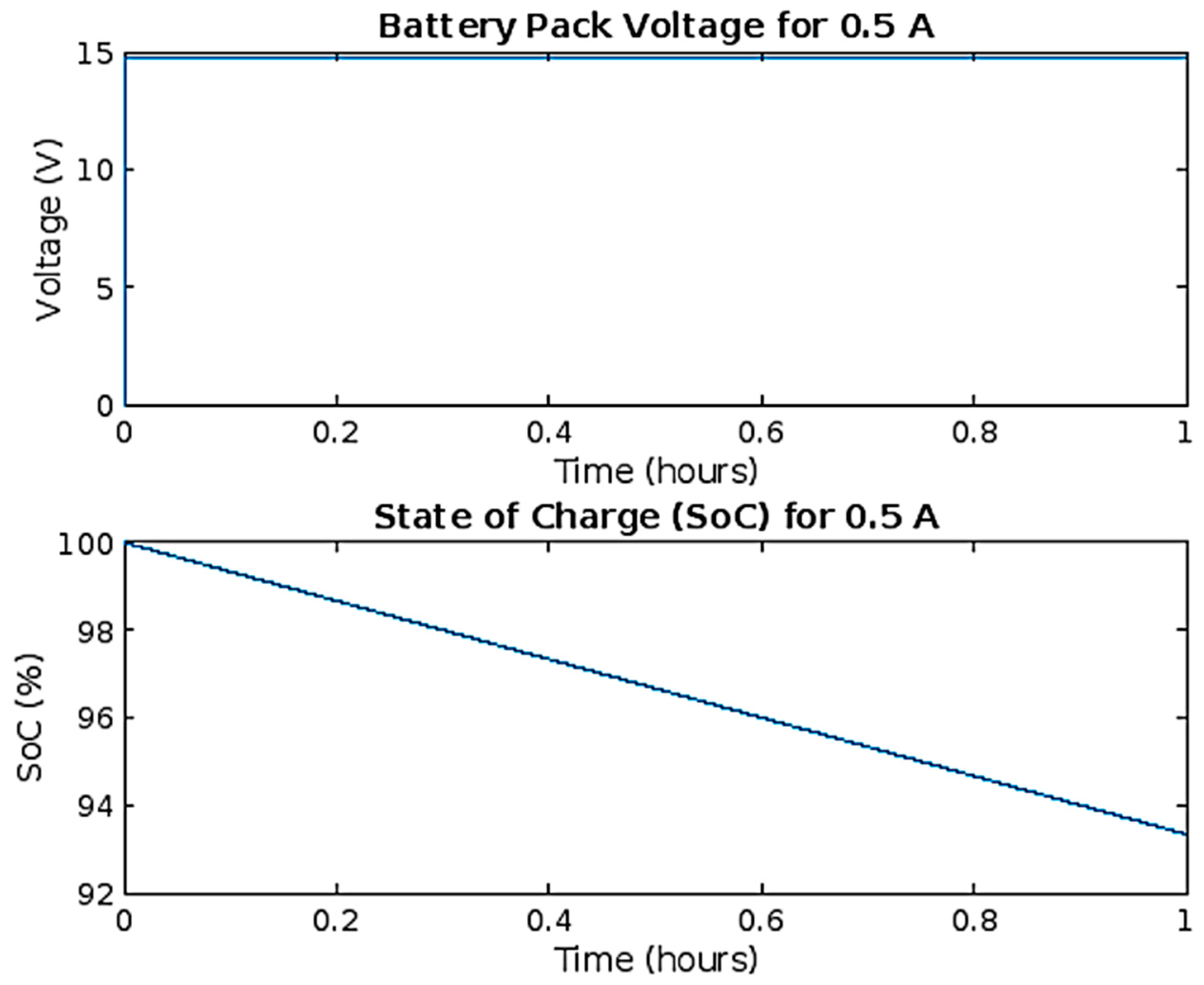
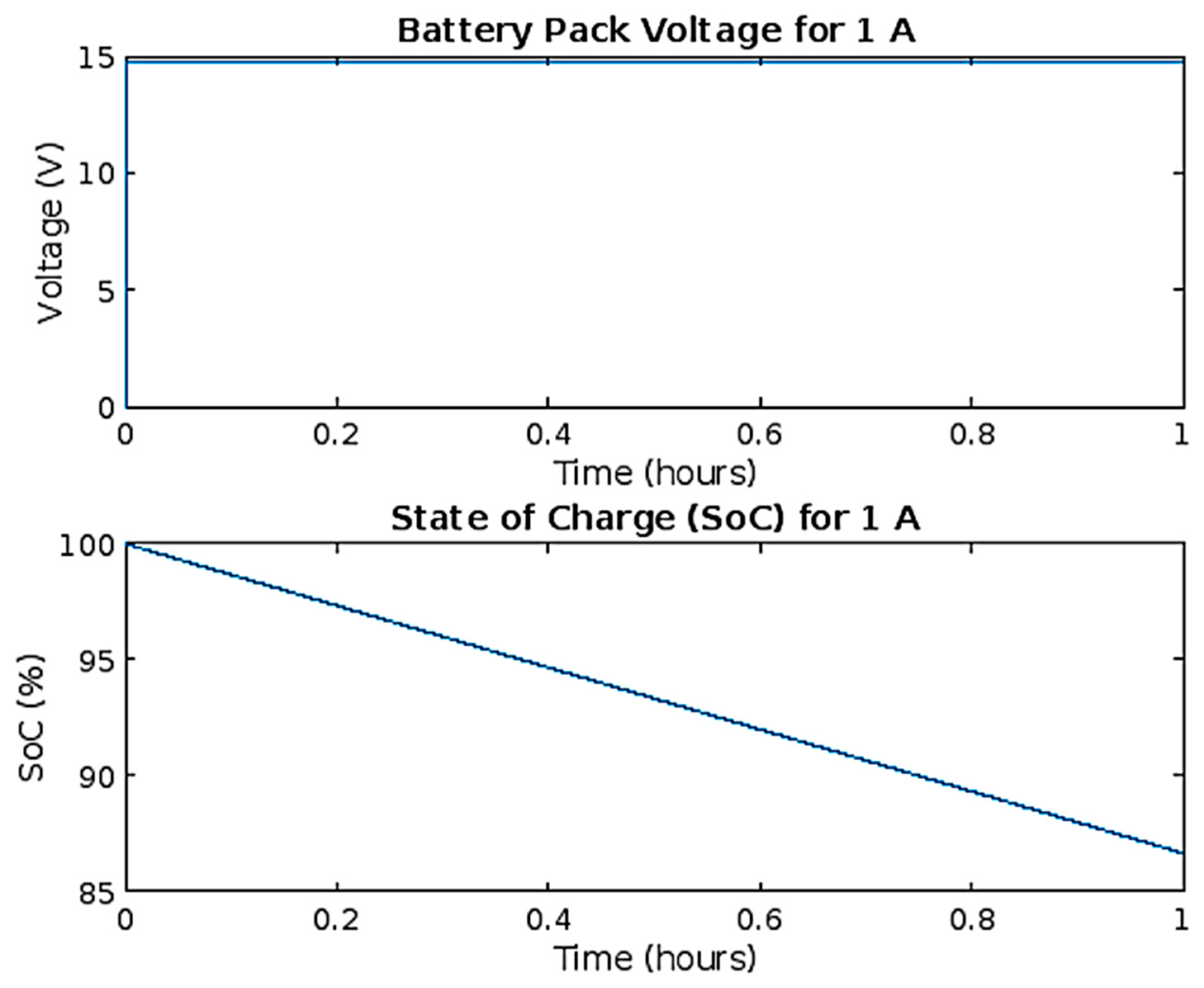

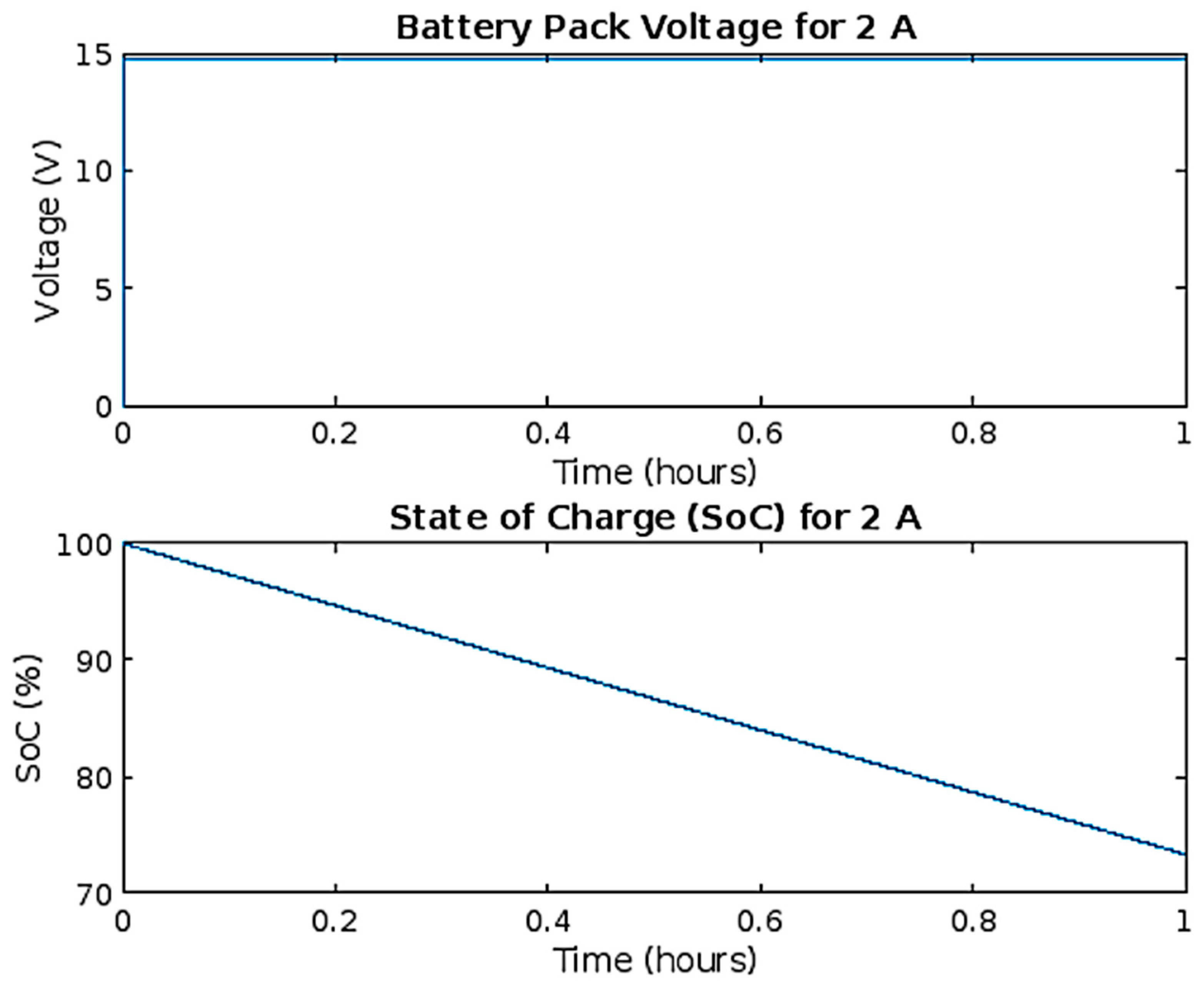
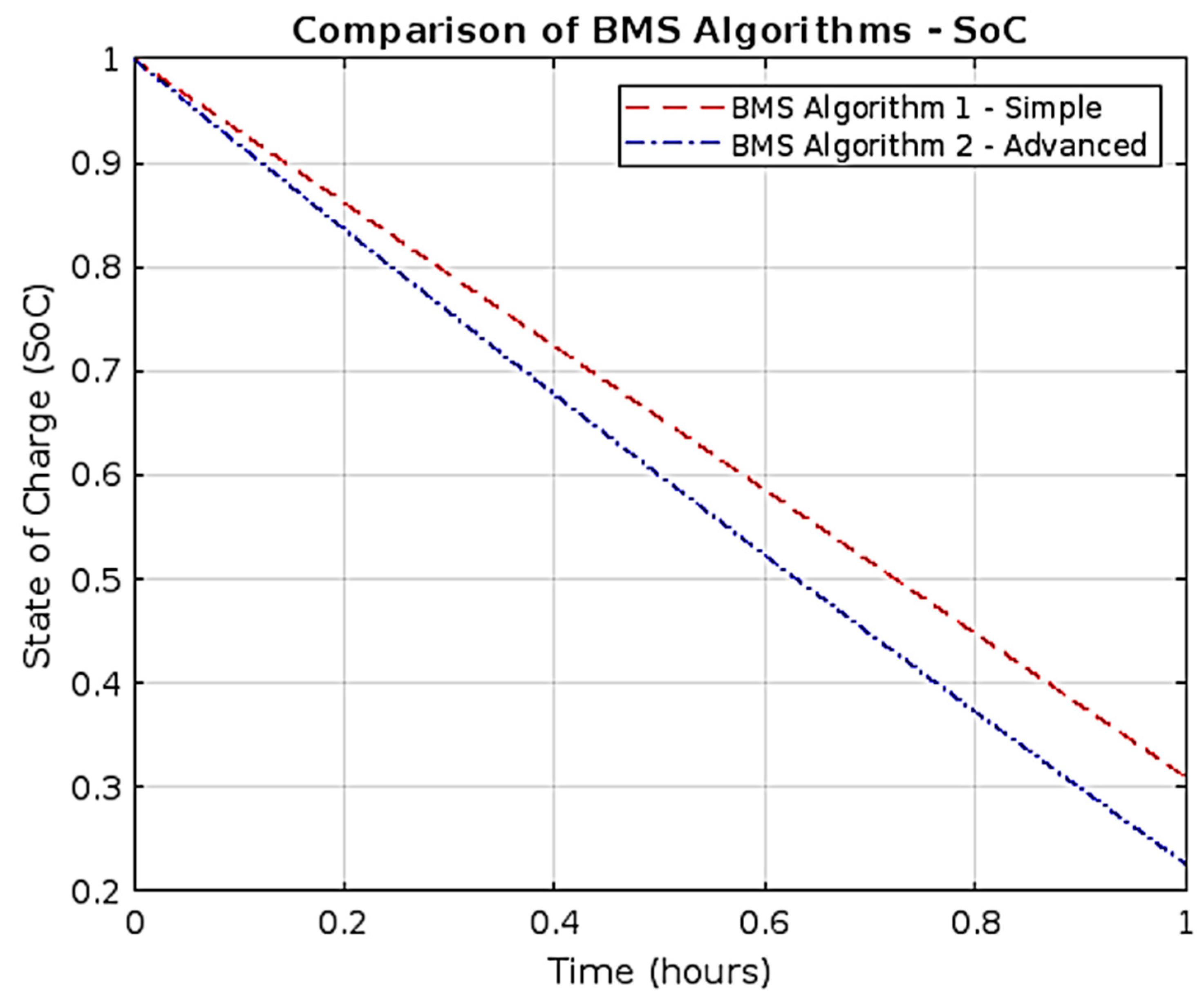
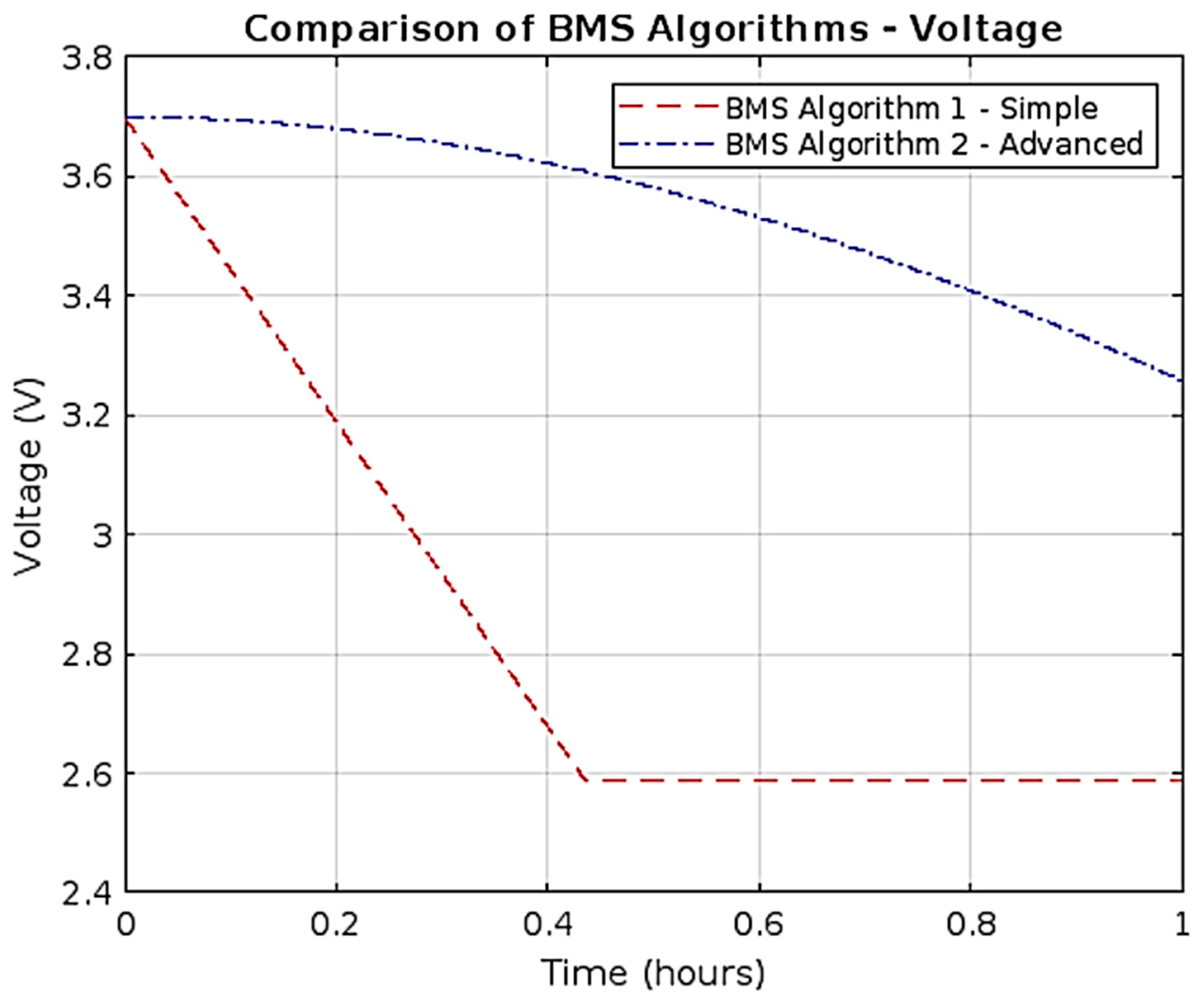
| Feature | Traditional BMS Methods | Modern BMS Methods |
|---|---|---|
| Methodology | Static models based on voltage-to-charge correlation and simple integration of current | Dynamic algorithms including VFFRLS and machine learning models |
| Adaptability | Low; struggles with varying operational conditions and environmental factors | High; adapts to changes in real-time, accommodating various conditions |
| Accuracy | Moderate; effective under stable conditions but prone to errors under variability | High; employs complex algorithms to ensure high precision under diverse scenarios |
| Real-time Data Handling | Limited; typically uses predefined data sets and lacks real-time processing capabilities | Robust; utilizes real-time data to dynamically adjust SOC and SOH estimations |
| Technological Integration | Minimal; often isolated to specific functions within the BMS | Comprehensive; integrates across multiple aspects of battery management |
| Predictive Capabilities | Basic; mainly reactive systems with limited forecasting ability | Advanced; predictive analytics enable proactive management and fault detection |
Disclaimer/Publisher’s Note: The statements, opinions and data contained in all publications are solely those of the individual author(s) and contributor(s) and not of MDPI and/or the editor(s). MDPI and/or the editor(s) disclaim responsibility for any injury to people or property resulting from any ideas, methods, instructions or products referred to in the content. |
© 2024 by the authors. Licensee MDPI, Basel, Switzerland. This article is an open access article distributed under the terms and conditions of the Creative Commons Attribution (CC BY) license (https://creativecommons.org/licenses/by/4.0/).
Share and Cite
Tapaskar, R.P.; Revankar, P.P.; Ganachari, S.V. Advancements in Battery Management Systems for Electric Vehicles: A MATLAB-Based Simulation of 4S3P Lithium-Ion Battery Packs. World Electr. Veh. J. 2024, 15, 222. https://doi.org/10.3390/wevj15060222
Tapaskar RP, Revankar PP, Ganachari SV. Advancements in Battery Management Systems for Electric Vehicles: A MATLAB-Based Simulation of 4S3P Lithium-Ion Battery Packs. World Electric Vehicle Journal. 2024; 15(6):222. https://doi.org/10.3390/wevj15060222
Chicago/Turabian StyleTapaskar, Rakesh P., Prashant P. Revankar, and Sharanabasava V. Ganachari. 2024. "Advancements in Battery Management Systems for Electric Vehicles: A MATLAB-Based Simulation of 4S3P Lithium-Ion Battery Packs" World Electric Vehicle Journal 15, no. 6: 222. https://doi.org/10.3390/wevj15060222
APA StyleTapaskar, R. P., Revankar, P. P., & Ganachari, S. V. (2024). Advancements in Battery Management Systems for Electric Vehicles: A MATLAB-Based Simulation of 4S3P Lithium-Ion Battery Packs. World Electric Vehicle Journal, 15(6), 222. https://doi.org/10.3390/wevj15060222








